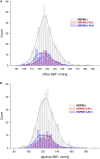Home blood pressure measurement for hypertension management in the real world: Do not just measure, but share with your physician
- PMID: 36742078
- PMCID: PMC9889357
- DOI: 10.3389/fcvm.2023.1103216
Home blood pressure measurement for hypertension management in the real world: Do not just measure, but share with your physician
Abstract
Introduction: Studies of the effectiveness of home blood pressure (BP) measurement on the treatment of hypertension in the real world are sparse, and the results are controversial. There is an efficacy-effectiveness gap in the treatment of hypertension using home BP measurements. We aimed to investigate the effect of reporting home BP to physicians on ambulatory BP control as a factor contributing to the efficacy-effectiveness gap in treating patients with hypertension.
Methods: We recruited patients ≥20 years of age taking antihypertensive drugs. Office and 24-h ambulatory BP were measured. A questionnaire to the measurement of home BP was conducted. Participants were divided into an HBPM(-) group, home BP was not measured (n = 467); HBPM(+)-R(-) group, home BP was measured but not reported (n = 81); and HBPM(+)-R(+) group, home BP was measured and reported (n = 125).
Results: The HBPM(+)-R(+) group had significantly lower office systolic BP (SBP, p = 0.035), 24-h SBP (p = 0.009), and daytime SBP (p = 0.016) than the HBPM(-) group, and lower nighttime SBP (p = 0.005) and diastolic BP (DBP, p = 0.008) than the HBPM(+)-R(-) group. In the multivariate analysis, the differences in 24-h SBP, daytime SBP, and nighttime DBP remained significant. There was a significant difference between groups in the target achievement rate of 24-h SBP (p = 0.046), nighttime SBP (p = 0.021), and nighttime DBP (p = 0.023). The nighttime SBP and DBP target achievement rates in the HBPM(+)-R(+) group were higher than those in the HBPM(+)-R(-) group (p = 0.006 and 0.010, respectively). Among patients measuring home BP, the adjusted odds ratio for 24-h and nighttime BP target achievement in the HBPM(+)-R(+) group were 2.233 and 3.658, respectively.
Conclusion: Home BP measurements should be reported to the treating physician to effectively manage hypertension.
Clinical trial registration: https://clinicaltrials.gov, identifier NCT03868384.
Keywords: ambulatory; blood pressure; home; hypertension; treatment.
Copyright © 2023 Rhee, Munakata, Nah, Kim and Kim.
Conflict of interest statement
The authors declare that the research was conducted in the absence of any commercial or financial relationships that could be construed as a potential conflict of interest.
Figures
Similar articles
-
Comparing the Effectiveness of Home, Clinic, and Kiosk Blood Pressure Checks for Diagnosing High Blood Pressure – The BP-CHECK Study [Internet].Washington (DC): Patient-Centered Outcomes Research Institute (PCORI); 2021 Aug. Washington (DC): Patient-Centered Outcomes Research Institute (PCORI); 2021 Aug. PMID: 39078929 Free Books & Documents. Review.
-
Home blood pressure in children and adolescents: a comparison with office and ambulatory blood pressure measurements.Acta Paediatr. 2011 Oct;100(10):e163-8. doi: 10.1111/j.1651-2227.2011.02300.x. Epub 2011 May 11. Acta Paediatr. 2011. PMID: 21457301
-
Home blood pressure monitoring in paediatric chronic hypertension.J Hum Hypertens. 2009 Jul;23(7):464-9. doi: 10.1038/jhh.2008.167. Epub 2009 Mar 12. J Hum Hypertens. 2009. PMID: 19279660
-
Home blood pressure during night-time sleep - a feasible treatment target for patients with hypertension: a proof-of-concept randomised controlled trial.J Pharm Policy Pract. 2025 Feb 14;18(1):2463435. doi: 10.1080/20523211.2025.2463435. eCollection 2025. J Pharm Policy Pract. 2025. PMID: 39968319 Free PMC article.
-
Clinical significance of nocturnal home blood pressure monitoring and nocturnal hypertension in Asia.J Clin Hypertens (Greenwich). 2021 Mar;23(3):457-466. doi: 10.1111/jch.14218. Epub 2021 Feb 16. J Clin Hypertens (Greenwich). 2021. PMID: 33591641 Free PMC article. Review.
Cited by
-
Self-care practices among hypertensive patients at the primary health care centers in Unaizah city, Saudi Arabia.Front Med (Lausanne). 2024 Dec 4;11:1290670. doi: 10.3389/fmed.2024.1290670. eCollection 2024. Front Med (Lausanne). 2024. PMID: 39697200 Free PMC article.
-
Status of home blood pressure measurement in treated hypertensive patients. Results of a survey from two cities in Korea.J Clin Hypertens (Greenwich). 2024 Jul;26(7):825-831. doi: 10.1111/jch.14808. Epub 2024 Jun 17. J Clin Hypertens (Greenwich). 2024. PMID: 38884638 Free PMC article.
-
Prevalence and Characteristics of Isolated Nighttime Masked Uncontrolled Hypertension in Treated Patients.Medicina (Kaunas). 2024 Sep 18;60(9):1522. doi: 10.3390/medicina60091522. Medicina (Kaunas). 2024. PMID: 39336563 Free PMC article.
References
-
- Ncd Risk Factor Collaboration (NCD-RisC). Worldwide trends in hypertension prevalence and progress in treatment and control from 1990 to 2019: a pooled analysis of 1201 population-representative studies with 104 million participants. Lancet. (2021) 398:957–80. 10.1016/s0140-6736(21)01330-1 - DOI - PMC - PubMed
-
- Sega R, Facchetti R, Bombelli M, Cesana G, Corrao G, Grassi G, et al. Prognostic value of ambulatory and home blood pressures compared with office blood pressure in the general population: follow-up results from the pressioni arteriose monitorate e loro associazioni (PAMELA) study. Circulation. (2005) 111:1777–83. 10.1161/01.cir.0000160923.04524.5b - DOI - PubMed
Associated data
LinkOut - more resources
Full Text Sources
Medical
Miscellaneous



